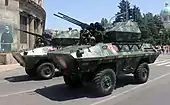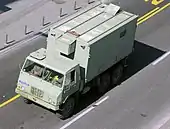Gendarmery (Serbia)
The Gendarmery (Serbian: Жандармерија, romanized: Žandarmerija) is the national gendarmerie force of Serbia, tasked with high-risk and specialized law enforcement duties. It is under the authority of the Police Directorate of the Serbian Police and consists of about 2,800 members.[2]
| Gendarmery Жандармерија Žandarmerija | |
|---|---|
 Patch of the Serbian Gendarmery | |
 Flag of the Serbian Gendarmery | |
| Agency overview | |
| Formed | 28 June 1860 (current form since 2001) |
| Preceding agency | |
| Employees | 2,800 (2017)[1] |
| Jurisdictional structure | |
| National agency | Serbia |
| Operations jurisdiction | Serbia |
| Governing body | Ministry of Internal Affairs |
| General nature | |
| Operational structure | |
| Overviewed by | Police Directorate |
| Headquarters | Belgrade |
| Agency executive |
|
History

The word žandarmerija is a French loanword ("gendarmerie"), and is pronounced "zhandarmeriya". The Žandarmerija corps date back to the Principality of Serbia, established on June 28, 1860, and originally consisted of 120 infantrymen and 15 cavalrymen. From 15 to 17 June 1862, the Serbian Gendarmerie played a crucial role in the conflicts around the Čukur fountain in Belgrade - a little more than 100 gendarmes opposed a Turkish force several hundred times stronger and practically saved Belgrade and Serbia. The 1884 Law on the Gendarmerie established the State Gendarmerie which was organized into detachments with one detachment in Belgrade and every district town. In 1919, the Gendarmerie became an integral part of the Royal Army of the Kingdom of Yugoslavia, tasked for watching over public order and security, maintaining order and peace and ensuring the execution of the laws. The Gendarmerie was subordinated to the Minister of Military Affairs in terms of supply, discipline and military training, and in terms of use, training, maintenance of public security and gendarmerie service - to the Ministry of the Internal Affairs. After World War II gendarmery was disbanded only to be re-establishe more than half a century later, in 2001, after the disbandment of the Special Police Units (Posebna Jedinica Policije, PJP).[1] One of its first major assignments of newly-formed Gendarmery was capture of the suspects in the assassination of Prime Minister Zoran Đinđić. That same year, the Counter-Terrorist Unit was established within Gendarmery, but was separated in 2007 to become an independent unit within the Police.[3] In 2005 the Persons and Infrastructure Protection Unit was established, to carry out close protection and technical protection tasks.[3][1] In 2011 the Gendarmery was reorganized and the First Quick Response Detachment was established, consisting of the specialist companies of all Gendarmery detachments along with the Diving Center.[3]
Missions
The Gendarmery's missions include:
- Restoring public peace and order if it has been heavily disturbed (including riot control)
- Countering organized crime, terrorist and other violent groups
- Repressing prison riots
- Providing security to the security-sensitive foreign embassies in Serbia (those of the United States, China, Russia, Germany, United Kingdom, France, Italy, Turkey, Israel, Croatia and Albania)
- Securing the 384 kilometers long and 5 km wide Ground Safety Zone along the administrative line between Serbia and Kosovo (in joint action with infantry battalions of the Serbian Army)
It may also perform any duties decreed in the laws and regulations.
Organization
Gendarmery is organized in four "detachments" (odredi), battalion-size units, each with their own territorial jurisdiction (based in Belgrade, Novi Sad, Niš, and Kraljevo).[1] Detachment is organized as independent unit in order to be able to execute every-day duties on its territory of jurisdiction although, if needed, can provide assistance to other detachments as well.[4] The structure of the detachment is as follows:

- Command
- General-purpose unit (composed of a general-purpose company and fire support platoon); specialized in crowd and riot control.
- Specialist unit (composed of: counter-terrorist company, reconnaissance platoon, sniper team, K-9 team and mine-explosive team), specialized in counterterrorism, fighting violent groups, organized crime groups.
- Security unit (company-size unit in Belgrade-based detachment, platoon-size unit in other detachments); specialized in tasks of physical and technical protection of sensitive sites (protection of certain foreign embassies in case of Belgrade-based detachment or other sensitive sites in case of other detachments).
- Armored vehicles unit, tasked with mechanized support to other units of the detachment.
In addition to the detachments deployed throughout the country, the Gendarmery has one specialized unit: the Diving Unit of the Gendarmery (Ronilačka jedinica Žandarmerije), headquartered in Belgrade.[1] It is tasked with conducting special actions in water-dominated environment and is consisted of three specialist teams: intervention team, searching team and nautical team.[3]
Equipment
Firearms
| Name | Country | Caliber | Notes |
|---|---|---|---|
| CZ 99 | Serbia | 9×19 Parabellum | In use also CZ999 |
| Glock 17 | Austria | 9×19 Parabellum | In use Glock 17 Gen 3 |
| SIG Sauer P 220 | Switzerland | 9×19 Parabellum | |
| Amadeo Rossi | Brasil | 357. Magnum | For training purposes |
| Smith&Wesson | U.S. | 357. Magnum | For training purposes |
| Zastava R83 | Serbia | 357. Magnum | For training purposes |
| HK MP5 | Germany | 9×19 Parabellum | In use A2,A3,SD3,K versions |
| Zastava M92 | Serbia | 7.62×39 | |
| Zastava M84 Škorpion | Yugoslavia | 7.65×17 | Personal Defense Weapon |
| Zastava M70 | Yugoslavia/Serbia | 7.62×39 | In use AB1,AB2 and modernised ABX versions |
| Zastava M21 | Serbia | 5.56×45 NATO | |
| MPi-KM | East Germany | 7.62×39 | |
| Colt M4 | U.S. | 5.56×45 NATO | A4 Commando version in use |
| Zastava M76 | Yugoslavia | 7.92×57 | |
| Zastava M91 | Serbia | 7.62×54R | |
| Steyr | Austria | 7.62×51 NATO | Tactical Elite |
| HK G3 | Germany | 7.62×51 NATO | |
| HK G33 | Germany | 5.56×45 NATO | |
| SIG Sauer 716 | Switzerland | 7.62×51 NATO | |
| Zastava M93 | Serbia | 12.7×108 | |
| Barrett M82 | U.S. | 12.7×99 NATO | |
| Barrett M95 | U.S. | 12.7×99 NATO | Bullpup sniper rifle |
| Zastava M84 | Yugoslavia/Serbia | 7.62×54R | |
| Browning M2 | U.S. | 12.7×99 NATO | Mounted only on vehicles |
| Zastava M93 | Serbia | 30mm | Automatic granade launcher |
Vehicles
Commanders
Since its establishment, the Serbian Gendarmery has had six Commanders:[1][5]
| No. | Portrait | Commander | Took office | Left office | Time in office | Minister of Internal Affairs |
|---|---|---|---|---|---|---|
| 1 | Colonel Goran Radosavljević (born 1957) | 28 June 2001 | 17 August 2004 | 3 years, 50 days | Dušan Mihajlović Dragan Jočić | |
| 2 | Colonel Borivoje Tešić (born 1956) | 17 August 2004 | 23 June 2008 | 3 years, 311 days | Dragan Jočić | |
| – | Colonel Srđan Grekulović (born 1962) Acting | 23 June 2008 | 3 June 2009 | 345 days | Dragan Jočić Ivica Dačić | |
| 3 | Colonel Bratislav Dikić (born 1970) | 3 June 2009 | 17 July 2013 | 4 years, 44 days | Ivica Dačić | |
| – | Colonel Milenko Božović (born 1965) Acting | 17 July 2013 | 2 August 2013 | 16 days | Ivica Dačić | |
| 4 | Colonel Milenko Božović (born 1965) | 2 August 2013 | 13 March 2015 | 1 year, 223 days | Ivica Dačić Nebojša Stefanović | |
| 5 | Colonel Goran Dragović (born 1967) | 13 March 2015 | 2 August 2018 | 3 years, 142 days | Nebojša Stefanović | |
| 6 | Colonel Dejan Luković | 2 August 2018 | Incumbent | 5 years, 84 days | Nebojša Stefanović Aleksandar Vulin Bratislav Gašić |
See also
References
- Jevtic, Milos (13 January 2017). "Serbian Gendarmerie". Spec Ops Magazine. Retrieved 10 July 2018.
- "Serbian Gendarmerie: With faith in God, for Holy Cross and Mother Serbia". 13 January 2017.
- "Gendarmerie of the Republic of Serbia". specijalne-jedinice.com. Archived from the original on 22 July 2018. Retrieved 10 July 2018.
- http://www.mup.gov.rs/wps/portal/sr/direkcija-policije/ojdpp/Zandarmerija/!ut/p/z1/04_Sj9CPykssy0xPLMnMz0vMAfIjo8zi_S19zQzdDYy83X3MjAwczbxN3X3dTYwNTA30w8EKDHAARwP9KPz6vQgpALrAqMjX2TddP6ogsSRDNzMvLV8_IioxLyWxKDe1KDMrEeiGKFRTLDzd3YCmGBh6BnibGRo4GaArcDdzBVoTaG7p4u1qYWzhAVOAxx8FuRFVPmnBnumOiooAGqZERQ!!/dz/d5/L0lDUmlTUSEhL3dHa0FKRnNBLzROV3FpQSEhL3NyX1JTXyNMYXRu/
- "Serbian ministries, etc". rulers.org. B. Schemmel. Retrieved 14 August 2018.
External links
- Official Žandarmerija of the Ministry of Internal Affairs
- Short video about Žandarmerija
- "Nadležnosti" [Duties]. Ministry of the Interior, Republic of Serbia (in Serbian)




















.png.webp)